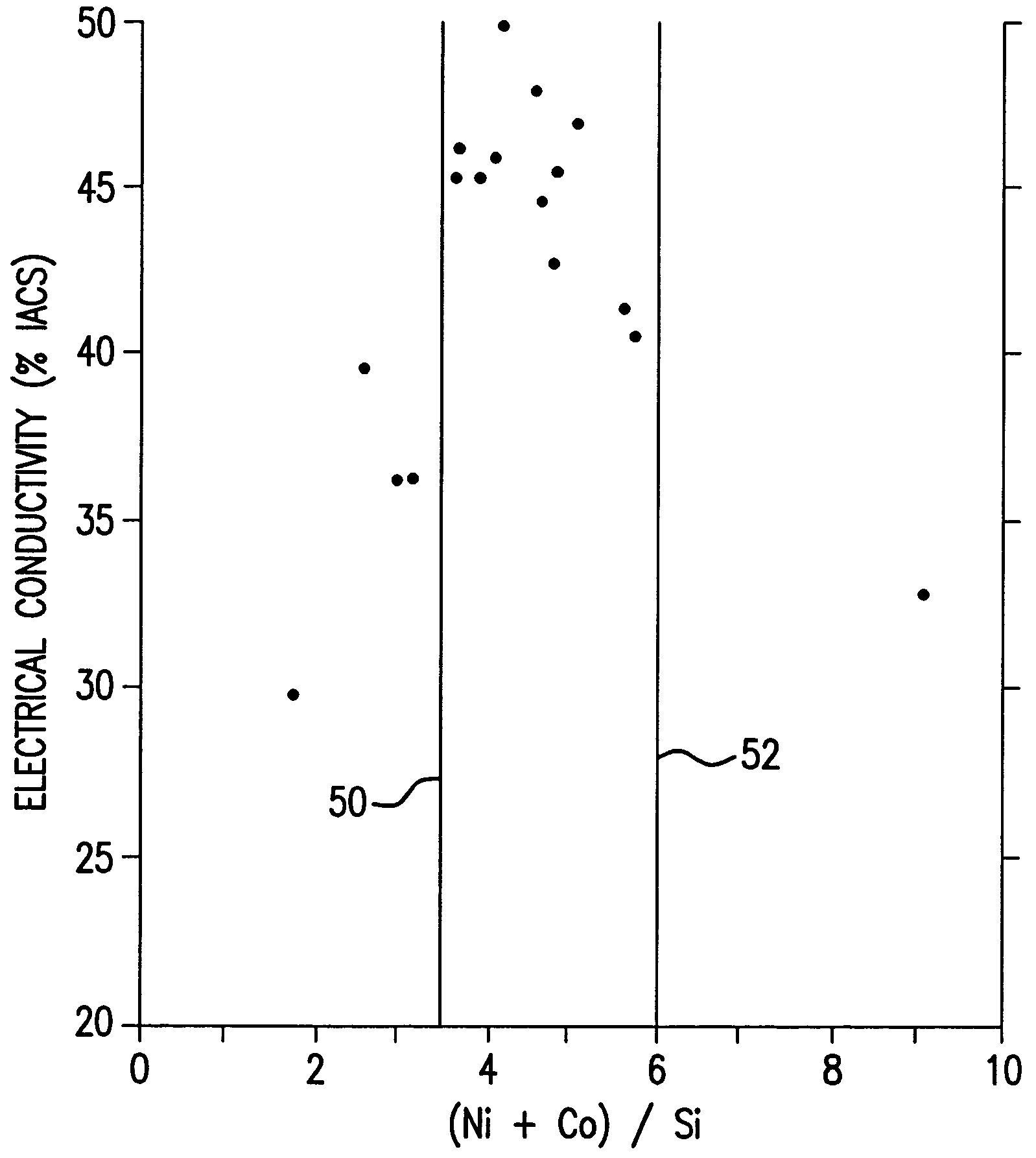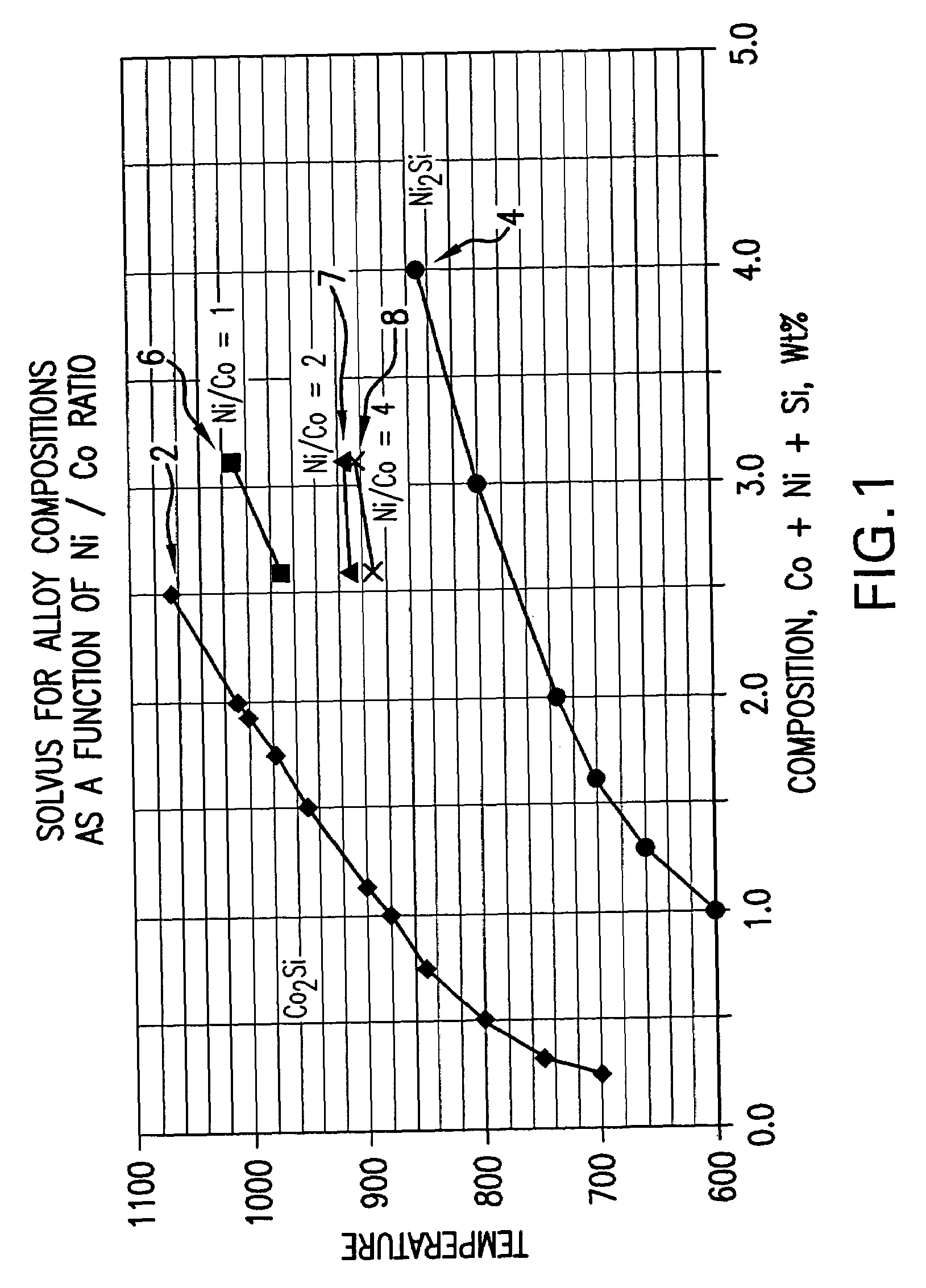Copper alloy containing cobalt, nickel and silicon
a technology of cobalt, nickel and silicon, applied in the field of copper alloys, can solve the problems of lack of required combination of properties, poor formability, and availability of alloys, and achieve the effects of high electrical conductivity, good formability, and high strength
- Summary
- Abstract
- Description
- Claims
- Application Information
AI Technical Summary
Benefits of technology
Problems solved by technology
Method used
Image
Examples
example 1
[0076]This example illustrates why the alloys of the invention have silicon and cobalt contents both in excess of 0.5 percent by weight.
[0077]Milled plate of the alloys listed in Table 2 was cold rolled to 0.016 inch and solutionized at temperatures from 800° C. to 1,000° C. for 60 seconds followed by a water quench 18. The grain size was measured by optical microscopy and is reported in Table 2. For alloy J724, at solutionizing temperatures of 900° C. and 950° C., the grain size is estimated rather than measured.
[0078]
TABLE 2Average Grain SizeIngot IDSolution Heat Treatment(microns)Alloys of the InventionJ401 850° C. / 60 seconds6 950° C. / 60 seconds16 J667 925° C. / 60 seconds5 950° C. / 60 seconds5 975° C. / 60 seconds5J671 925° C. / 60 seconds5 950° C. / 60 seconds5 975° C. / 60 seconds5J719 900° C. / 60 seconds7 950° C. / 60 seconds81000° C. / 60 seconds14 J720 900° C. / 60 seconds6 950° C. / 60 seconds81000° C. / 60 seconds20 J721 900° C. / 60 seconds8 950° C. / 60 seconds81000° C. / 60 seconds30 J722 900° C....
example 2
[0080]This example illustrates the effect of maintaining the silicon content in excess of 0.5% and the total amount of nickel and cobalt between 1.7% and 4.3% for a combination of high yield strength and high electrical conductivity.
[0081]The milled plates were cold rolled to 0.016 inch and solutionized at 950° C. for 60 seconds followed by a water quench. These alloys were first aged at 525° C. for 3 hours, cold rolled to a thickness reduction of 25% to 0.0120 inch gauge and second aged at 425° C. for 6 hours. The yield strength and electrical conductivity combinations achieved are listed in Table 3 as are 90° good way and bad way bend formability.
[0082]
TABLE 3Nickel +YieldElectricalSiliconCobaltStrengthConductivity90° MBR / tAlloy(weight %)(weight %)(ksi)(% IACS)GWBWAlloys of the InventionJ7390.562.4211052.72.22.2J7400.713.0411352.82.72.3J7410.813.3311652.52.22.5J7420.943.8111851.72.33.9J7431.134.3211851.03.03.9Comparative ExamplesJ7370.381.6910456.5N.D.N.D.J7380.442.0010854.12.02.3...
example 3
[0084]This example illustrates that Ni / Co ratios above 2 provide maximum yield strength while Ni / Co ratios less than 1 provide better electrical conductivity at finish gauge. Milled plates of the alloys listed in Table 4 were cold rolled to 0.016 inch and solutionized at a temperature of between 900° C. and 1000° C. for 60 seconds followed by a water quench. These alloys were first age annealed at 525° C. for 3 hours, cold rolled to a thickness reduction of 25% to 0.0120 inch gauge and then second age annealed at 425° C. for 6 hours.
[0085]The mechanical and electrical properties of the alloys at finish gauge are recited in Table 4. The data show a reduced Ni / Co ratio increases electrical conductivity and decreases yield strength. The dependency of both yield strength and electrical conductivity on Ni / Co ratio is unexpected.
[0086]
TABLE 4Finish Gauge PropertiesElectricalYield StrengthConductivityAlloyNi:Co Ratio(ksi)(% IACS)J719-0-104.854.0J7200.52113.047.7J7211.06115.346.8J7222.17116...
PUM
| Property | Measurement | Unit |
|---|---|---|
| grain size | aaaaa | aaaaa |
| yield strength | aaaaa | aaaaa |
| yield strength | aaaaa | aaaaa |
Abstract
Description
Claims
Application Information
 Login to View More
Login to View More - R&D
- Intellectual Property
- Life Sciences
- Materials
- Tech Scout
- Unparalleled Data Quality
- Higher Quality Content
- 60% Fewer Hallucinations
Browse by: Latest US Patents, China's latest patents, Technical Efficacy Thesaurus, Application Domain, Technology Topic, Popular Technical Reports.
© 2025 PatSnap. All rights reserved.Legal|Privacy policy|Modern Slavery Act Transparency Statement|Sitemap|About US| Contact US: help@patsnap.com



